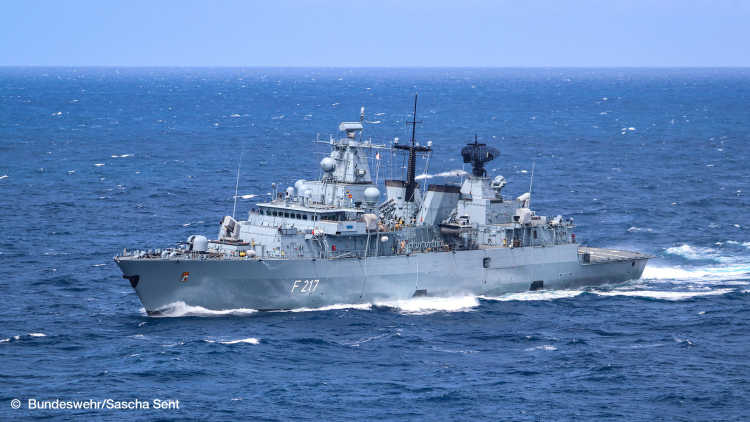- Home
- Publications
- GIGA Focus
- Broadening Horizons: "Indo-Pacific" Maritime Politics beyond China
GIGA Focus Asia
Broadening Horizons: "Indo-Pacific" Maritime Politics beyond China
Number 6 | 2019 | ISSN: 1862-359X

China’s expanding presence in the South China Sea has prompted European governments to join the United States and its East Asian allies in their mission to secure the “liberal rules-based order” across the Indian and Pacific Oceans. Yet without understanding the historical and regional contexts, efforts at strengthening the rule of international law may well produce the opposite of the desired outcome.
In 2016, the Chinese government refused to participate in and accept the outcome of the Philippines-induced arbitration proceedings concerning the interpretation of “historical rights” and the designation of “islands” according to the United Nations Convention on the Law of the Sea in the South China Sea.
Against the background of President Xi Jinping’s rolling out of the Belt and Road Initiative, this reinforced the view – especially in Washington, Tokyo, and Canberra – that China is seeking to overturn the United States-led liberal rules-based order. Yet, the narrow focus on Chinese actions distracts from the broader political context.
Policymakers’ preoccupation with nationally conceived “sea lanes of communication” and conflation of the freedom of navigation for warships with the economic reality of transnationally interconnected maritime transport routes has exacerbated long-standing maritime disputes.
Predictions about China’s coming global dominance and concomitant efforts to defend the “West” are reminiscent of the Australian, European, and United States reactions to the rise of Japan in the 1980s. This must alert policymakers to the fallacies of tunnel vision on non-Western rising powers.
Policy Implications
European decision-makers must resist the temptation to supersize China as a common threat for the purpose of fixing transatlantic relations and overcoming discord within the European Union. The further militarisation of Indo-Pacific seas can only be avoided if all militarily present actors ratify the United Nations Convention on the Law of the Sea and related agreements. They must also acknowledge that the Convention is the result of a grand political bargain, take others’ security concerns into account, and focus on the preservation of the marine environment.
From Squabbles over a Few Rocks to the End of the “West”
Judging from a cursory look at mass media headlines, the current state of world affairs can be explained in two words: “Trump” and “China.” The former embodies the spread of populism; the latter represents the rise of “Asia.” But while hope prevails that democracy and global free trade can survive Trumpian assaults, the mood – especially in Washington, Tokyo, and Canberra – is decidedly more pessimistic when it comes to authoritarian China’s challenging of the “liberal rules-based order.” What, though, do these buzzwords stand for, how is the world really changing, and what will the consequences for Europe be?
Without the escalation of Sino–Japanese disputes over the control of a few rocks in the East China Sea and Sino–United States contestations over navigational rights for warships in exclusive economic zones (EEZs) of the South China Sea, the notions of the rules-based order and of the “Indo-Pacific” would unlikely have emerged and gained such prominence. As recent as 2008, only hard-headed nationalists would have thought that these long-standing squabbles could spiral out of control so quickly, and become the defining signifiers of a changing world order. The various disputes over small groups of uninhabited islets, rocks, reefs, and shoals far out in the ocean were seen as merely overblown intra-Asian issues.
Yet, not only the entry into force of the United Nations Convention on the Law of the Sea (UNCLOS) in 1994 and the strengthening of nationalistic currents in the post–Cold War period but also heightened pressures to find new “engines” of national economic growth would significantly exacerbate territorial conflicts. Against this background, lingering concerns about the freedom of navigation along nationally conceived maritime transport routes – so-called sea lanes of communication (SLOCs) – allowed political interest groups to redefine and weave disparate maritime security issues together into irresistibly simple geopolitical explanations of international political developments. On top of the threat perceptions that spread from the territorial disputes in the East and the South China Seas to the Pacific and across the Indian Ocean, an arbitration tribunal’s 2016 verdict denied legitimacy to the Chinese government’s claims to “historical rights” and attribution of “island” status to several geographical features in the South China Sea. This decision cast an even more intense spotlight on China’s brazen reclamation and fortification of military outposts in the same area. Especially in Europe, the continent that sees itself as the champion of international law and norms, China’s image shifted from that of an assertive regional power to a great one that challenges the law of the sea – if not international law itself.
European Union policymakers came to see China as not only a cooperation partner, negotiating partner, and economic competitor, but also as a “systemic rival promoting alternative models of governance” (EC 2019: 1). According to this view, China challenges the rules-based international order that the EU defines as the multilateral system of governance based on the United Nations and its three pillars of human rights, peace and security, and development (EC 2019: 2). Yet, if the rule of law is to prevail over the rule by force and halt multiple great powers’ quests to aggressively assert their rediscovered spheres of influence, contentions over the interpretation of specific legal principles need to be separated out from questions of world order.
To clarify these points, the subsequent section outlines the background and stakes in East Asian maritime territorial disputes. The section thereafter discusses how the politics of the international law of the sea fit into this picture. Before making policy recommendations, the last section briefly compares the contemporary reactions towards the rise of China with those towards a previous instance of a rising Asian power: that is, Japan in the 1980s. This will help to reframe the main questions and problems that policymakers now face.
Rival Claims to East Asian Maritime Space
The maritime delimitation disputes that most East Asia states have with all of their respective neighbours go back to how European, Japanese, and US imperial possessions were reorganised into newly sovereign, territorially defined nation states. A root cause thereof is the failure of US diplomats to take into account East Asian concerns, and to clearly determine who would henceforth have sovereign ownership of the many islets and rocks that Imperial Japan had controlled up until 1945. At the same time, post-independence power struggles in China, Korea, the Philippines, and Vietnam meant that these few small islets and rocks were beyond East Asian elites’ cognitive horizons, or of marginal importance.
This situation changed when UNCLOS codified norms that attributed unprecedented legal importance to “islands” and “rocks.” Unlike rocks, which establish 12 nautical mile (NM)-wide territorial seas, islands – defined as “naturally formed area of land, surrounded by water, which is above water at high tide” that can “sustain human habitation or economic life of their own” (UNCLOS Article 121) – are also entitled to EEZs up to 200 NM wide. In addition, islands generate exclusive rights to the seabed resources on so-called continental shelves far beyond. Thirsty for industrial raw materials, coastal states have thus “discovered” various islands and rocks as new territories “inherent” to their nations since “time immemorial.” This projection of national boundaries and populations into the distant past seriously complicates the delineation of the East Asian semi-enclosed seas’ many overlapping zones.
Moreover, once the global Cold War ended, the unfreezing of grievances stemming from wartime violence rekindled feelings of victimhood and deepened political divides along disputed borderlines. Especially after a 2010 controversy between China and Japan over the Diaoyu/Senkaku islets in the East China Sea, it became hard to say whether problems of history propelled largely symbolic disputes over a few uninhabited rocks or vice versa. Although bitter fights over the acknowledgement and compensation of wartime forced labourers outweigh the dispute over the Dokdo/Takeshima rocks, this assessment is also true for Japan–South Korea relations too.
Yet, intra-Asian conflicts do not occur in a vacuum. Latent concerns about the security of SLOCs accentuated and linked disparate maritime delimitation disputes in the drive to reinforce grand geopolitical narratives. In 1994 already, a Japanese expert panel identified maritime supply lines as “a matter of life and death” (Kantei 1994), and used it to partially fill the security political void left by the Soviet Union’s collapse. Soon, rising China overshadowed piracy in the Malacca Straits as the main perceived threat to Japan-bound shipping through Southeast Asia. While conservative Japanese leaders, still in the grip of the defeat of 1945, remained obsessed with their country’s vulnerability to naval blockade, Chinese Communist Party (CCP) leaders continued to be caught up in the trauma of their victimisation at the hand of imperial powers – including the loss of Taiwan first to Imperial Japan and then to the Chinese Nationalists. That is, Chinese leaders themselves would grow increasingly worried about the continuously rising dependence on imported Middle Eastern oil and the possibility that the all-mighty US Navy and its powerful Japanese ally may put a stranglehold on China’s economy. Therefore President Hu Jintao, mirroring Japanese fears, in 2003 enunciated China’s “Malacca Dilemma.”
Foreshadowing the Barack Obama administration’s predicament of maintaining workable Sino–US relations while reassuring Pacific allies, these anxieties were reinforced when the Bill Clinton administration in 1996 responded to Chinese intimidation of Taiwanese voters via ballistic missile testing. Clinton’s dispatch of aircraft carrier strike groups and inclusion of a Taiwan Strait contingency plan into US (first strike) nuclear war planning, combined with talk about the establishment of a US-led ballistic missile defence shield over the Western Pacific, prompted Chinese leaders to redouble their efforts at military modernisation. At the same time, Japanese leaders were shocked to hear that President Clinton in 1998 spent nine days on a state visit to China without even stopping over in Japan. This episode of “Japan-passing” continues to remind conservative Japanese officials of the possibility that the US might abandon Japan, and has prompted them to give the utmost priority to the strengthening of their alliance until the present day.
This geopolitical manoeuvring cast longer and longer shadows over the South China Sea too, and reopened a long-standing fault line in global maritime politics. Following the in Chinese eyes humiliating accidental bombing of their embassy in Belgrade by US forces in 1999, the 2001 controversy over the collision of a US spy plane with a Chinese fighter jet over the South China Sea highlighted the fundamental differences in how the US and China view key UNCLOS provisions. Since signing UNCLOS, China – similar to other developing countries – has insisted on the necessity of prior permission for foreign warships navigating its EEZ. The US, however, has long been a major proponent of the opposing view that warships remain free to navigate wherever they wish, as long as the results of their surveillance activities off the Chinese coast and in China-claimed waters are not used for commercial purposes. Hence, a continuous string of incidents at sea and in the air have fuelled Sino–US – and, indirectly, Sino–Japanese – antagonisms ever since.
Against this backdrop, the Obama administration in 2010 announced the so-called pivot towards Asia-Pacific – encompassing the shifting of 60 percent of its naval and overseas air force assets to the Pacific, and the continued strengthening of bilateral trans-Pacific alliances. At the level of military doctrine, this included the adoption of the “Air-Sea Battle” concept for countering the “Anti-Access and Area Denial” strategy that China allegedly pursued to prevent US forces from operating in the Western Pacific (Fravel and Twomey 2014). Whether intended or not, the Chinese leadership invariably saw this strategy for deterring China and reassuring US allies as yet another move to curb China’s rise and secure US primacy. As a consequence, Chinese leaders came to define new unnegotiable “core interests” in the disputed waters. Reminiscent of President Clinton’s earlier predicament, Obama’s move, paradoxically, only heightened US allies’ demands for reassurance.
These confrontations significantly hardened the Chinese stance and stoked nationalistic currents. In Chinese mass media coverage, the three-phrased narrative describing the violation of China’s rights – framed as “water territories have been carved up, islands and reefs have been occupied, and resources have been plundered” (Wang 2015: 520) – gained prominence. In all of these domains, China was portrayed as the victim. Feeling bullied, Chinese leaders redoubled their efforts at increasing “Comprehensive National Power” through boosting defence spending and accelerating gross domestic product growth. This, gradually but decisively, increased their emphasis on the so-called blue economy, an immensely powerful growth engine that China would need to control and harness in order to become a “maritime great power” (haiyang daguo) and to fulfil the CCP’s cardinal mission of national rejuvenation (Wirth 2017).
This projection of Chinese desires into East Asian seas means that to renounce maritime territorial claims would come close or even be tantamount to giving up the “China Dream” of achieving national modernisation (Wirth 2019a). Consequently, the perceived threats to the Chinese party state from East Asian seas, combined with the economic problems caused by the 2008 global financial crisis, gave rise to the grand One Belt One Road vision. Furthermore, they triggered the move to fortify now-enlarged rocks, islets, and reefs in the Spratly area of the South China Sea from late 2013 onwards.
UNCLOS and the Rules-Based Order
Unsurprisingly, Chinese expansion invited widespread condemnation and countermoves. Especially China’s heavy-handed approach in a 2012 confrontation at Scarborough Shoal prompted President Benigno Aquino III of the Philippines to initiate proceedings for the establishment of an arbitration tribunal according to UNCLOS Annex VII. The tribunal’s award of July 2016 brought a welcome clarification of key legal terms. The judges applied strict interpretations of “island” and “rock,” confirmed the very limited role of “historical rights” as a means to claim territories and exclusive economic rights, and reminded coastal states’ of their duty to protect the marine environment. Thus, even though the tribunal had no legal authority and therefore did not decide on the disputed territorial delimitation, the verdict was a blow to Chinese practices.
There had to be a response to China’s moves to control nearly all of the South China Sea within the so-called Nine-Dash Line. Also because China’s ongoing refusal to define its claims according to UNCLOS principles and render them negotiable is detrimental to peaceful settlement. Yet, the arbitration case also raises a number of difficult questions. Without at least giving them due consideration, policies designed to strengthen the law of the sea and avert hostilities will be ineffective, and likely continue to backfire.
First, if the freedom of navigation is under threat in the South China Sea, this danger stems from the very geopolitical moves that rival naval powers make in the name of protecting it. Contrary to the mythical elevation of SLOCs to national economic bloodlines, global maritime transport routes cannot be nationalised. They are international public goods, and no one can reasonably claim ownership or proclaim sole guardianship of them. Moreover, the availability of alternative routes circumventing the South China Sea or even around Australia (Noer and Gregory 1996) means that actual threats to SLOCs can only come from all-out war on land. The realistic possibility that the US–Iran conflict will disrupt crude oil shipments from the Gulf region through the Strait of Hormuz to Northeast Asia reveals the fallacy of the geopolitical logic of seeking to secure Chinese, Japanese, and others’ SLOCs in the South China Sea.
More problematic still, the focus on SLOC security erases from contemporary debates on the rules-based order the fact that the UNCLOS treaty results from a grand bargain. A historically unprecedented number of participating states reached it over decades of negotiation. This was made possible only after the two main opposing camps had reached a compromise. On the one hand, the developed naval powers had long favoured unhindered navigation, especially for their warships; on the other, the mostly newly independent developing countries sought control over their coastal resources while keeping the former imperial powers and their warships at bay. The diametrically opposed positions of China and the US on the peaceful and expedient “innocent passage” of warships through territorial seas, the more liberal “transit passage” (e.g. submarines do not have to surface and fly their flags) along internationally used routes, as well as oceanographic research in EEZs all point to the continued fragility of this bargain.
Several incidents have laid bare the politics underlying these interpretations of international law. Unlike with China, India’s, Japan’s, and others’ in principle similarly restrictive interpretations of the applicability of the transit passage regime as well as scientific research and naval surveillance activities in EEZs have not elicited much attention or criticism. Responses have been largely limited to formal diplomatic protests backed up by occasional military diplomatic action under the US Freedom Of Navigation Program. While the US acknowledges the right of Chinese warships to operate in its EEZ and sail through US territorial seas, their first appearances off Hawaii and Alaska clearly stirred anxieties. Also, Australian analysts – normally champions of the freedom of navigation – were alarmed when Chinese warships observed military exercises from within the Australian EEZ (Wirth 2019b). Apparently, not only China worries about foreign military surveillance off its coast and uses its EEZ as a reference point for defining foreign threats.
Second, the instrumental use of “historical rights” and “islands” for claiming excessive EEZs and extended continental shelves is the norm rather than the exception. While also the other coastal states employ them to claim all (Taiwan) or very large parts (Vietnam) of the South China Sea, the practice is particularly beneficial for former colonial powers. It is made even more lucrative through the modus operandi of the Commission on the Limits of the Continental Shelf (CLCS). A scientific body established through UNCLOS, the CLCS is tasked with making recommendations to coastal states regarding the establishment of the outer limits of their continental shelves further than 200 NM away from the coast. Since there is no higher authority for making decisions on these limits, the 21 CLCS members – a clear majority of whom represent the major stakeholders – tend to mutually recognise their claims to enormous swathes of the seabed and resources therein. Examples beyond China and the South China Sea are: the Australian Heard Island and McDonald Islands, and Mellish Reef; New Zealand’s Kermadec Islands; France’s Clipperton Island; Japan spending over USD 1.5 billion to ensure that the Okinotorishima rocks stay above water (Wirth 2017: 86); and, various US claims in the Western and Southern Pacific (Song 2018).
Third, there is the question of a dispute’s admissibility to judicial settlement. China’s refusal to participate in the arbitration, and subsequent rejection of the verdict, has widely been portrayed as proof that it is seeking to overturn the rules-based order. Yet, contemporary international law provides only very few exceptions that allow for overriding state sovereignty. Thus, the initiation of legal proceedings requires consent from all involved parties. Whereas China expressly excluded compulsory dispute settlement in 2006, Australia, France, the United Kingdom, and others all excluded or limited this possibility already upon signing UNCLOS; the US Senate remains unwilling to even sign it. Thus, determining under what circumstances a state can force another to go to court must depend on whether this will be conducive to the mitigation of a particular dispute – and for strengthening the UNCLOS regime as a means of peaceful dispute resolution in general (cf. Proelss 2018).
These points do not justify Chinese claims, but they essentially reduce the problem to one of how coastal states – China, as the most powerful actor, bears a particular responsibility – handle their disputes over a few uninhabited reefs and rocks – not islands. If, however, the message is that you are breaking the rules because you are not us, it is unsurprising that Chinese decision-makers reject claims of authoritative interpretation solely based on regime status of “democracy.” Thus Chinese stakeholders have come to believe that they are criticised not because their behaviour is wrong, but because they are militarily inferior. The consequence is the weakening of international law and steeper cascades of coercion whereby the powerful, instead of being subjected to the rule of law, rule by law. Exemplary for this trend is the gradual convergence in both Chinese and foreign debates about the actual nature of the Nine-Dash Line towards treating it as a de facto maritime boundary – one to be defended and opposed respectively at all costs.
What Order Is Really Changing, and What to Do about It
According to the Australian scholar Nick Bisley, the “rules-based formulation [of order]” is “contrasted to a power-based order.” The former is commonly “presented as a value-neutral and technical-legal fact in which we, the Western powers, do the right things and the outliers [like China] break the rules” (Bisley 2018). This narrow focus on China clouds the view on more fundamental processes of transformation and on risks, leading policymakers to embark on counterproductive efforts to revive what is retrospectively seen as a stable or even glorious past.
First, while Chinese claims in the South China Sea do not conform to UNCLOS provisions, uninformed officials anxiously marvelling at China’s GDP growth rates often succumb to questionable activism. Just as it is doubtful that peace can be secured through preparations for war, their efforts to secure the freedom of navigation for warships are not conducive to safeguarding the freedom of the seas. Indicative of this trend is the Japanese militarisation of the Ryukyu (Okinawa) Islands in response to China’s of the Spratlys, and the US, Indian, Australian, and British pre-emption of an anticipated Chinese “string of pearls” strategy of establishing naval facilities across the Indo-Pacific by actually expanding their own ones. Second, as the clear warning from the Singaporean prime minister at the 2019 Shangri-La Dialogue made evident, the US and China need to become aware of the deepening security dilemma existing between themselves and stop pressuring governments, businesses, as well as academics worldwide to choose sides. More generally, great powers should refrain from carving out new spheres of influence in the Indo-Pacific.
Third, pointing to the “China threat” allows politicians to implement economic and security policies that curtail civil liberties. Since many can easily claim to wield more democratic legitimacy than their Chinese or, for that matter, North Korean rivals and enemies, this sort of benchmarking creates significant room for the degradation of democratic institutions. The term democracy is gradually emptied of meaning.
Many of the problems with Indo-Pacific maritime politics stem from the erroneous perception that we are facing a clash of civilisations. China and others thus are seen to threaten what is retrospectively portrayed as a stable, peaceful order that had until now existed – unchanging – for no less than 70 years. According to several high officials, the US is preparing for an unprecedented “fight with a really different civilisation; a great power competitor that is not Caucasian” (Gehrke 2019; see also, Pence 2018).
Unfortunately, extreme Chinese policies like the mass detention of ethnic Uyghur citizens and the making of expansive claims in the South China Sea compound the widespread difficulties of coming to terms with the dark sides of this Western liberal rules-based order – think of the Korean, Vietnam, Iraq, Afghanistan, and other wars. Powerholders in places like Washington and Canberra tend to discredit criticisms of their self-assigned missions to defend “the West” as siding with Chinese voices that level critiques of “orientalism” and “Cold-War thinking” for their own ends. Thus, the recent waves of China scare in the US and Australia prompted former Australian prime minister Kevin Rudd to warn about the re-emergence of something akin to the Cold War era communist witch-hunt, in the forms of a new McCarthyism or the reconstitution of the Committee on the Present Danger – “where any of us seeking to explain the complexity of China’s rise are pronounced guilty of un-American [or un-Australian] activities” (Rudd 2018: 60–61).
Yet, if the liberal rules-based order stands for the US-centric system built around Cold War era Asia-Pacific alliances, then the decline of this “West” is no surprise. After all its nemesis, the Communist Bloc, already disappeared 30 years ago. The CCP’s continued grappling with the events of 1989 testifies to this. It is also questionable whether China will be able to dominate world or even East Asian regional politics; a look back at recent history provides some guidance here. Just as policy planners in Washington have overlooked the fact that the US had been engaged in fierce battles with another “non-Caucasian” power not too long ago, current commentators forget about the panic that a rising Japan caused in the 1980s. Then, “Japan Inc.” was famously touted as a model to be emulated by the US and other struggling industrial economies, with the East Asian country making symbolically very powerful purchases such as the Rockefeller Center in New York, threatening US and European industries, and funding large-scale infrastructure projects in China, Central and Southeast Asia, and in Africa.
The hype about the “Japan problem” in the 1980s reveals the force with which the economic rise of a non-Caucasian state can undermine US and European confidence in their own political and economic systems. There is no clearer proof of the fallacies of accompanying predictions about emerging hegemons and changing world orders than the desperate and vain efforts by contemporary Japanese elites to bring back past growth and greatness. If the rise of Japan, a democratic US military ally with a then very restrictive defence policy and a population 10 times smaller than China’s, could stir this much anxiety, what mirages is the rise of the Chinese “dragon” able to generate?
These inconvenient truths do not make Chinese actions less problematic, but they do prompt us to ask different questions that demand different responses. First, the US and China should respect each other’s and their smaller neighbours’ security concerns and stop military surveying in foreign coastal waters irrespective of their zoning. Second, all parties involved in Indo-Pacific maritime politics should ratify UNCLOS and related agreements. Third, policymakers worldwide should focus their attention on the urgent task of preserving fish stocks and marine ecosystems. To this end European decision-makers should listen to and work with those (smaller) East Asian states not harbouring great power aspirations, and support regional and global mechanisms of marine environment management. Finally, if European leaders do indeed see China as a “systemic rival” then they must work harder at improving the EU so that it can remain a model to be emulated – and be wary of appropriating the very behaviours that they criticise others for.
As George Kennan (1946) noted at the end of his well-known long telegram sent from the US embassy in Moscow to Washington: “It is not enough to urge people to develop political processes similar to our own. Many foreign peoples […] are tired and frightened by [the] experiences of [the] past, and are less interested in abstract freedom than in security. […] We must have [the] courage and self-confidence to cling to our own methods and conceptions of human society. After all, the greatest danger that can befall us in coping with this problem [of Soviet communism], is that we shall allow ourselves to become like those with whom we are coping.”
Footnotes
References
Bisley, Nick (2018), Australia’s Rules-Based International Order, www.internationalaffairs.org.au/australianoutlook/australias-rules-based-international-order/ (30 July 2019).
EC (European Commission) (2019), EU-China – A Strategic Outlook, Joint Communication to the European Parliament, the European Council and the Council, 12 March 2019.
Fravel, M. Taylor, and Christopher P. Twomey (2014), Projecting Strategy: The Myth of Chinese Counter-Intervention, in: The Washington Quarterly, 37, 4, 171–187.
Gehrke, Joel (2019), State Department Preparing for Clash of Civilizations with China, in: The Washington Examiner, 30 April 2019.
Kantei (1994), The Modality of the Security and Defense Capability of Japan, Report, 12 August, http://worldjpn.grips.ac.jp/documents/texts/JPSC/19940812.O1E.html (30 July 2019).
Kennan, George (1946), The Charge in the Soviet Union (Kennan) to the Secretary of State, Moscow, George Washington University National Security Archive, https://nsarchive2.gwu.edu//coldwar/documents/episode-1/kennan.htm (30 July 2019).
Noer, John H. with Daniel Gregory (1996), Chokepoints: Maritime Economic Concerns in Southeast Asia, Washington, DC: National Defense University Press.
Pence, Mike (2018), Remarks Delivered by President Mike Pence on the Administration’s Policy towards China at Hudson Institute, www.hudson.org/events/1610-vice-president-mike-pence-s-remarks-on-the-administration-s-policy-towards-china102018 (30 July 2019).
Proelss, Alexander (2018), The Limits of Jurisdiction Rationae Materiae of UNCLOS Tribunals, in: Hitotsubashi Journal of Law and Politics, 46, 47–60.
Rudd, Kevin (2018), The United States and China—The Avoidable War, An Address to the Conference on the New China Challenge, The United States Naval Academy, Annapolis, https://asiasociety.org/policy-institute/united-states-andchina-avoidable-war (30 July 2019).
Song, Yann-huei (2018), The July 2016 Arbitral Award, Interpretation of Article 121(3) of the UNCLOS, and Selecting [sic] Examples of Inconsistent State Practices, in: Ocean Development and International Law, 49, 3, 247–261.
Wang, Zheng (2015), Chinese Discourse on the “Nine-Dashed Line” Rights, Interests, and Nationalism, in: Asian Survey, 55, 3, 502–524.
Wirth, Christian (2019a), Emotions, International Hierarchy, and the Problem of Solipsism in Sino-US South China Sea Politics, forthcoming in: International Relations.
Wirth, Christian (2019b), Whose ‘Freedom of Navigation’? Australia, China, the US, and the Making of Order in the ‘Indo-Pacific’, in: The Pacific Review, 32, 4, 475–504.
Wirth, Christian (2017), Danger, Development, and Legitimacy in East Asian Maritime Politics: Securing the Seas Securing the State, London: Routledge.
General Editor GIGA Focus
Editor GIGA Focus Asia
Editorial Department GIGA Focus Asia
Regional Institutes
Research Programmes
How to cite this article
Wirth, Christian (2019), Broadening Horizons: "Indo-Pacific" Maritime Politics beyond China, GIGA Focus Asia, 6, Hamburg: German Institute for Global and Area Studies (GIGA), http://nbn-resolving.de/urn:nbn:de:0168-ssoar-64161-3
Imprint
The GIGA Focus is an Open Access publication and can be read on the Internet and downloaded free of charge at www.giga-hamburg.de/en/publications/giga-focus. According to the conditions of the Creative-Commons license Attribution-No Derivative Works 3.0, this publication may be freely duplicated, circulated, and made accessible to the public. The particular conditions include the correct indication of the initial publication as GIGA Focus and no changes in or abbreviation of texts.
The German Institute for Global and Area Studies (GIGA) – Leibniz-Institut für Globale und Regionale Studien in Hamburg publishes the Focus series on Africa, Asia, Latin America, the Middle East and global issues. The GIGA Focus is edited and published by the GIGA. The views and opinions expressed are solely those of the authors and do not necessarily reflect those of the institute. Authors alone are responsible for the content of their articles. GIGA and the authors cannot be held liable for any errors and omissions, or for any consequences arising from the use of the information provided.
















